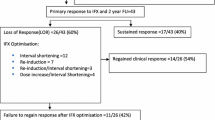Abstract
Background
The aim of this study was to assess the long-term usage patterns and safety of infliximab in patients with Crohn’s disease in clinical practice.
Methods
The medical records of 492 unselected patients treated with infliximab at Mayo Clinic were reviewed and abstracted for demographic features, usage patterns, and adverse events.
Results
The patients received a median of seven infusions and had a median follow-up of 6.3 years. Twenty-eight patients (6 %) were lost to follow-up, 63 patients (13 %) had no clinical benefit, and 401 patients (80 %) had partial or complete response. Of the responding patients, 114 (28 %) received induction treatment only, 167 (42 %) received initial episodic treatment (62 switched to scheduled maintenance treatment of whom 32 [42 %] were still on infliximab at last follow-up), and 120 (30 %) received scheduled maintenance treatment (56 patients [32 %] still on infliximab at last follow-up). Three patients (0.6 %) developed septic shock and six patients (1.5 %) developed septicemia. One patient (0.2 %) developed Mycobacterium avium complex. Histoplasmosis occurred in three patients (0.6 %). The cumulative 10-year probability for developing cancer after infliximab was 9 %. Among the 31 patients developing malignancies (6 %), 15 (3 %) had solid tumors, 11 (2 %) had melanoma and non-melanoma skin cancers, three (0.6 %) had lymphomas (0.6 %), and two (0.4 %) had leukemia. Overall 10-year survival after the final course of infliximab was 94 %. Among the 28 deaths (6 %), nine occurred within 12 weeks of an infliximab infusion—two of these deaths were due to infections.
Conclusions
Long-term follow-up of patients with Crohn’s disease who were treated with infliximab initially between 1998 and 2002 showed persistence of therapy (due to clinical benefit) and an acceptable safety profile, despite the fact that less than one-third initially received three-dose induction followed by scheduled maintenance therapy. Infections and malignancy occurred at rates similar to those previously reported.



Similar content being viewed by others
References
Baumgart DC, Sandborn WJ. Inflammatory bowel disease: clinical aspects and established and evolving therapies. Lancet. 2007;369:1641–1657.
Targan SR, Hanauer SB, van Deventer SJ, et al. A short-term study of chimeric monoclonal antibody cA2 to tumor necrosis factor alpha for Crohn’s disease. Crohn’s disease cA2 study group. N Engl J Med. 1997;337:1029–1035.
Present DH, Rutgeerts P, Targan S, et al. Infliximab for the treatment of fistulas in patients with Crohn’s disease. N Engl J Med. 1999;340:1398–1405.
Hanauer SB, Feagan BG, Lichtenstein GR, et al. Maintenance infliximab for Crohn’s disease: the ACCENT I randomised trial. Lancet. 2002;359:1541–1549.
Sands BE, Anderson FH, Bernstein CN, et al. Infliximab maintenance therapy for fistulizing Crohn’s disease. N Engl J Med. 2004;350:876–885.
Keane J, Gershon S, Wise RP, et al. Tuberculosis associated with infliximab, a tumor necrosis factor alpha- neutralizing agent. N Engl J Med. 2001;345:1098–1104.
Lee JH, Slifman NR, Gershon SK, et al. Life-threatening histoplasmosis complicating immunotherapy with tumor necrosis factor alpha antagonists infliximab and etanercept. Arthritis Rheum. 2002;46:2565–2570.
Brown SL, Greene MH, Gershon SK, et al. Tumor necrosis factor antagonist therapy and lymphoma development: twenty-six cases reported to the food and drug administration. Arthritis Rheum. 2002;46:3151–3158.
Siegel CA, Marden SM, Persing SM, et al. Risk of lymphoma associated with combination anti-tumor necrosis factor and immunomodulator therapy for the treatment of Crohn’s disease: a meta-analysis. Clin Gastroenterol Hepatol. 2009;7:874–881.
Mackey AC, Green L, Liang LC, et al. Hepatosplenic T cell lymphoma associated with infliximab use in young patients treated for inflammatory bowel disease. J Pediatr Gastroenterol Nutr. 2007;44:265–267.
Farrell RJ, Shah SA, Lodhavia PJ, et al. Clinical experience with infliximab therapy in 100 patients with Crohn’s disease. Am J Gastroenterol. 2000;95:3490–3497.
Cohen RD, Tsang JF, Hanauer SB. Infliximab in Crohn’s disease: first anniversary clinical experience. Am J Gastroenterol. 2000;95:3469–3477.
Ricart E, Panaccione R, Loftus EV, et al. Infliximab for Crohn’s disease in clinical practice at the Mayo Clinic: the first 100 patients. Am J Gastroenterol. 2001;96:722–729.
Arnott ID, McDonald D, Williams A, et al. Clinical use of infliximab in Crohn’s disease: the Edinburgh experience. Aliment Pharmacol Ther. 2001;15:1639–1646.
Hommes DW, van de Heisteeg BH, van der Spek M, et al. Infliximab treatment for Crohn’s disease: one-year experience in a Dutch academic hospital. Inflamm Bowel Dis. 2002;8:81–86.
Sample C, Bailey RJ, Todoruk D, et al. Clinical experience with infliximab for Crohn’s disease: the first 100 patients in Edmonton, Alberta. Can J Gastroenterol. 2002;16:165–170.
Colombel JF, Loftus EV Jr, Tremaine WJ, et al. The safety profile of infliximab in patients with Crohn’s disease: the Mayo clinic experience in 500 patients. Gastroenterology. 2004;126:19–31.
Schnitzler F, Fidder H, Ferrante M, et al. Long-term outcome of treatment with infliximab in 614 patients with Crohn’s disease: results from a single-centre cohort. Gut. 2009;58:492–500.
Fidder H, Schnitzler F, Ferrante M, et al. Long-term safety of infliximab for the treatment of inflammatory bowel disease: a single-centre cohort study. Gut. 2009;58:501–508.
Cottone M, Kohn A, Daperno M, et al. Advanced age is an independent risk factor for severe infections and mortality in patients given anti-tumor necrosis factor therapy for inflammatory bowel disease. Clin Gastroenterol Hepatol. 2011;9:30–35.
Biancone L, Petruzziello C, Orlando A, et al. Cancer in Crohn’s disease patients treated with infliximab: a long-term multicenter matched pair study. Inflamm Bowel Dis. 2011;17:758–766.
Conflicts of interest
WJ Sandborn, J-F Colombel, and EV Loftus have served as consultants for Janssen Biotech. WJ Sandborn, J-F Colombel, and EV Loftus have received research support from Janssen Biotech.
Author information
Authors and Affiliations
Corresponding author
Rights and permissions
About this article
Cite this article
Seminerio, J.L., Loftus, E.V., Colombel, JF. et al. Infliximab for Crohn’s Disease: The First 500 Patients Followed Up Through 2009. Dig Dis Sci 58, 797–806 (2013). https://doi.org/10.1007/s10620-012-2405-z
Received:
Accepted:
Published:
Issue Date:
DOI: https://doi.org/10.1007/s10620-012-2405-z




